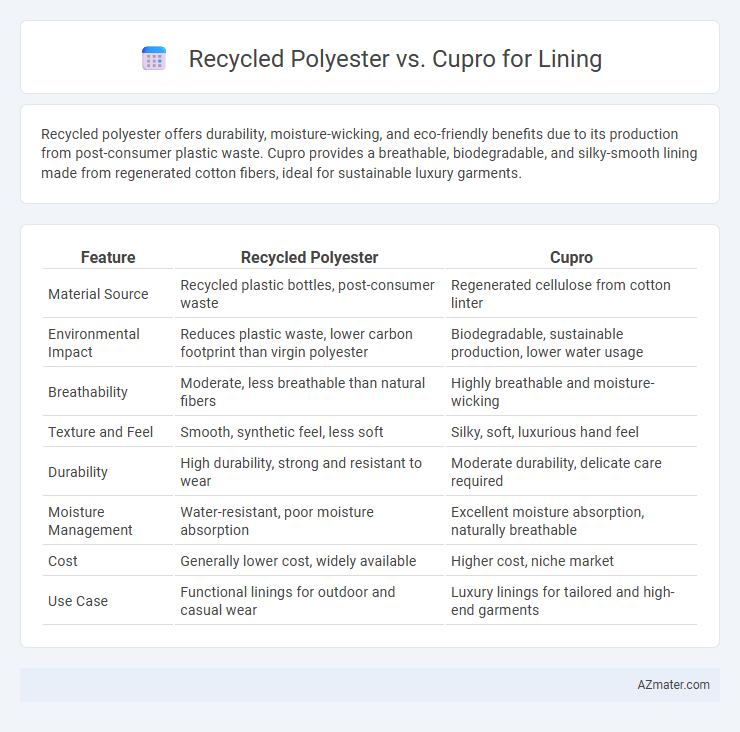Recycled polyester offers durability, moisture-wicking, and eco-friendly benefits due to its production from post-consumer plastic waste. Cupro provides a breathable, biodegradable, and silky-smooth lining made from regenerated cotton fibers, ideal for sustainable luxury garments.
Table of Comparison
| Feature | Recycled Polyester | Cupro |
|---|---|---|
| Material Source | Recycled plastic bottles, post-consumer waste | Regenerated cellulose from cotton linter |
| Environmental Impact | Reduces plastic waste, lower carbon footprint than virgin polyester | Biodegradable, sustainable production, lower water usage |
| Breathability | Moderate, less breathable than natural fibers | Highly breathable and moisture-wicking |
| Texture and Feel | Smooth, synthetic feel, less soft | Silky, soft, luxurious hand feel |
| Durability | High durability, strong and resistant to wear | Moderate durability, delicate care required |
| Moisture Management | Water-resistant, poor moisture absorption | Excellent moisture absorption, naturally breathable |
| Cost | Generally lower cost, widely available | Higher cost, niche market |
| Use Case | Functional linings for outdoor and casual wear | Luxury linings for tailored and high-end garments |
Overview: Recycled Polyester vs Cupro for Lining
Recycled polyester lining offers durability, moisture-wicking properties, and sustainability by repurposing plastic waste, making it ideal for environmentally-conscious fashion brands. Cupro, derived from cotton linter waste, provides a breathable, silky texture and excellent moisture absorption, enhancing comfort in luxury garments. Both materials present eco-friendly alternatives with distinct performance characteristics, where recycled polyester excels in strength and Cupro in natural softness and biodegradability.
What Is Recycled Polyester?
Recycled polyester is a sustainable fabric made from repurposed plastic bottles and textile waste, reducing environmental impact compared to virgin polyester. It offers durability, moisture resistance, and ease of care, making it an ideal choice for linings in fashion and upholstery. Compared to cupro, recycled polyester provides greater wrinkle resistance and color retention but lacks the natural breathability of this regenerated cellulose fiber.
What Is Cupro Fabric?
Cupro fabric is a regenerated cellulose fiber made from cotton linter, a byproduct of cotton production, known for its silk-like softness and breathability. Unlike recycled polyester, which is derived from melted plastic bottles offering durability and moisture-wicking properties, Cupro is biodegradable and provides excellent moisture absorption and comfort. This makes Cupro a sustainable and luxurious choice for lining materials in textiles and fashion.
Sustainability Comparison: Recycled Polyester and Cupro
Recycled polyester, made from post-consumer plastic waste, significantly reduces landfill impact and conserves petroleum resources, offering a durable and moisture-wicking lining option. Cupro, derived from regenerated cellulose fibers of cotton linter, provides biodegradability and a lower environmental footprint due to its natural origins and closed-loop production processes. While recycled polyester excels in resource reuse and durability, Cupro stands out for its eco-friendly biodegradability and minimal chemical use, creating a balanced sustainability comparison for lining materials.
Texture and Comfort Differences
Recycled polyester offers a smooth, slightly slippery texture that enhances breathability and moisture-wicking, making it ideal for activewear linings. Cupro, derived from cellulose fibers, provides a silky, soft feel with excellent moisture absorption, resulting in superior comfort and temperature regulation. The key difference lies in Cupro's natural fiber origins offering a more breathable and luxurious hand compared to the synthetic and durable nature of recycled polyester.
Breathability and Moisture Management
Recycled polyester lining offers excellent moisture management by wicking sweat away from the skin, while its synthetic fibers may reduce breathability compared to natural alternatives. Cupro, a regenerated cellulose fiber derived from cotton scraps, provides superior breathability and natural moisture absorption, promoting enhanced comfort in garments. Both materials contribute to sustainability, but Cupro excels in facilitating airflow and regulating humidity within clothing linings.
Durability and Longevity
Recycled polyester offers high durability and resistance to wear, making it ideal for long-lasting garment linings that withstand frequent use and washing. Cupro, a regenerated cellulose fiber, provides a smooth, breathable lining but tends to be less durable and may degrade faster under heavy abrasion compared to recycled polyester. Selecting recycled polyester ensures enhanced longevity in linings due to its robust fiber structure and resistance to pilling and stretching.
Cost and Availability
Recycled polyester lining is cost-effective, often priced between $3 to $7 per yard, and widely available due to its mass production from post-consumer plastic waste. Cupro lining, derived from regenerated cellulose fibers, tends to be more expensive, typically ranging from $20 to $40 per yard, with limited availability because of its niche, sustainable manufacturing process. Manufacturers choosing between the two often weigh recycled polyester's affordability and supply chain reliability against cupro's premium feel and eco-friendly credentials.
Suitability for Various Garments
Recycled polyester offers durability and moisture resistance, making it suitable for linings in activewear, outerwear, and budget-friendly suits where performance and sustainability are prioritized. Cupro, derived from cellulose fibers, provides a silky texture, breathability, and natural moisture-wicking properties, ideal for luxury suits, blouses, and tailored garments requiring comfort and elegance. The choice between recycled polyester and cupro depends on garment type, desired tactile experience, and environmental considerations, with cupro favored for premium applications and recycled polyester preferred for functional, eco-conscious options.
Which Lining Material Is Right for You?
Recycled polyester offers durability, moisture-wicking properties, and sustainability benefits due to its production from post-consumer plastic waste, making it ideal for eco-conscious consumers seeking performance. Cupro, a regenerated cellulose fiber derived from cotton linter, provides a luxurious, breathable, and biodegradable option, perfect for those prioritizing comfort and natural fiber content in linings. Choosing between recycled polyester and Cupro depends on your preferences for environmental impact, fabric feel, and garment performance requirements.

Infographic: Recycled polyester vs Cupro for Lining
 azmater.com
azmater.com